During this amazing field we visited Deep Woods which is located in Laurelville, Ohio. We were fortunate enough to encountered with many plants including the Appalachian Gametophyte, haircap moss, butternut, chestnut oak, and many many ferns, and not to mention the Dogwood Leaf Trick. This particular area of southeastern Ohio is known for its sandstone hills, acidic, lack of nutrient in soil, and for it s dry substrates. This mountainous area is considered to be the part of the Appalachia. Thus, our hike was very adventurous. In our first assignment we were required to document four species which we saw during our field trip and also that were mentioned in the Geobotany Article by Jane Forsyth.
Eastern Hemlock (Tsuga canadensis)

The Eastern Hemlock is a native evergreen tree, found from Nova Scotia to eastern Minnesota, south to Maryland and Illinois, and along the Appalachian Mountains to Georgia and northern Alabama.It has small papery cones about 3/4 inch long that hang downward from branches. They turn red in the fall and contains a single seed. According to the article “Antioxidant and Antibacterial Properties of Norway Spruce (Picea abies H. Karst.) and Eastern Hemlock (Tsuga canadensis (L.) Carrière) Cone Extract” the bark of the eastern hemlock by Native Americans was used in antiseptics, cold medicines, and remedies for rheumatism and arthritis.
Chestnut Oak (Quercus prinus)
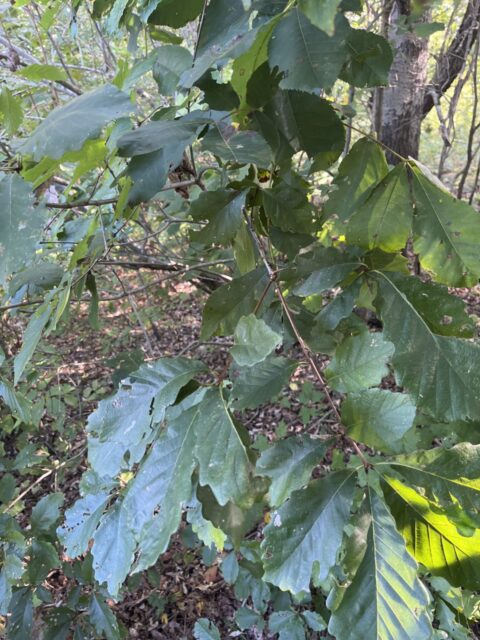
The Chestnut oak is a member of the white oak group with chestnut-like leaves. It prefers full sun and dry, well drained soil, therefore it is native to the Eastern United States. Its bark is dark, fussed into broad ridges. The leaves of this plant is alternate, obovate to oblong lanceolate, wedge shaped or rounded at its base. Furthermore, it has staminate flowers that born in hairy catkins two or three inch long. Lastly, the acorn of the chestnut oak is usually annually or in pairs present on this tree. The article “Alternative Fuels from Forestry Biomass Residue: Torrefaction Process of Horse Chestnuts, Oak Acorns, and Spruce Cones” mentions that chestnut can be used for many things, for example, people can make furniture, flooring, barrels, and veneer from the tree. Furthermore, some people also like to eat the acorns of the plant.
Sourwood (Oxydendrum arboreum)
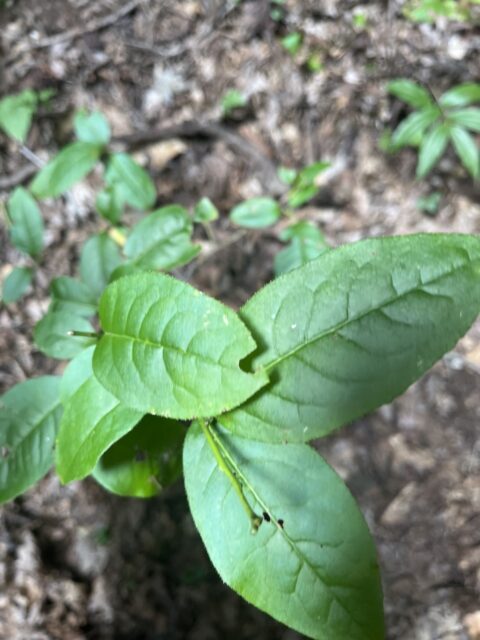
The sourwood is a medium sized tree, prefers full sun and it can be mostly spotted on ridges rising above the banks of streams. It has a grayish brown bark tinged with red and deeply furrowed with scaly ridges. The bark often appears blocky like that of persimmon. The leaves are alternate, simple, oblong to lance shaped and 3 to 8 inch long. Leaf tips taper to a point and leaf margins are minutely toothed. As you can see on the picture its summer leaves are glossy green. The plant has a pleasant acidic taste and it can be used for asthma, dysentery, diarrhea, kidney and bladder ailments. According to the article “Sourwood Oxydendrum arboreum: The Honey Tree” the Native Americans used leaf infusions for treating menstrual and menopause problems.
Lowbush Blueberry (Vaccinium angustifloium)
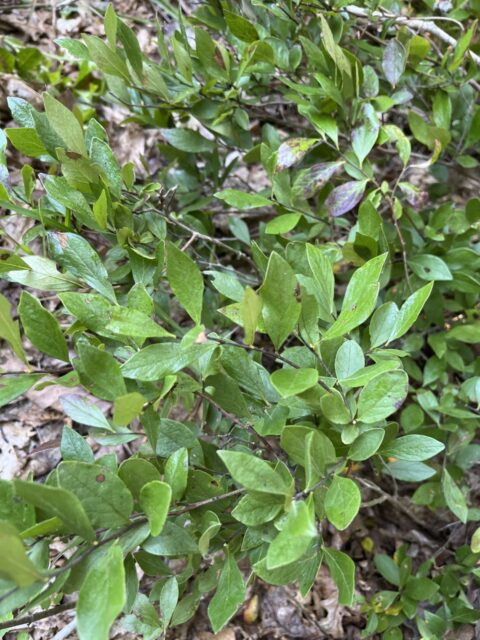
Lowbush blueberry prefers sand prairies, shrub prairies, sandy savannas, sandy woodlands, rocky upland woodlands, rocky bluffs, sand dunes along Lake Michigan. Sometimes it can be a dominant shrub in some of these habitats.They grow to knee-height or shorter. They sprawl as they mature.It has simple, lanceolate leaves in an alternate arrangement and serrate margins. The leaf color is dark green in summer and becomes reddish bronze in the fall. The flowers of the lowbush blueberry are bell shaped and around 5 mm long and bloom in May. The berries are small and very sweet which can be eaten freshly picked or incorporated into a variety of recopies. They have been shown to protect against heart disease and cancer, and can also help maintain bone strength and mental health. The article “Feeding Rats Diets Enriched in Lowbush Blueberries for Six Weeks Decreases Ischemia-induced Brain Damage” talks about the potential benefits of consuming blueberries as they are able to reduce the sized of tumors and prevent cancer development.
Biotic Threats to Forest Health
During our field trip we talked about three trees, namely the American chestnut, the Butternut, and the Eastern hemlock and how these species are affected by specific insect and/or fungus diseases here in Ohio. First, I would like to talk about the Butternut (Juglans cinerea) and the biotic threats on these plants by fungus, namely Sirococcus calvigignentijunglandacearum. This fungal disease is called butternut canker and it kills the trees progressively as the cankers girdling up the stem or kill the crown of the tree. This process cuts off nutrient and water transportation to all parts of the tree. Cankers can occur on all woody parts of the Butternut, including twigs, branches, stems and buttress roots. A possible way to mange this disease is by cutting off the infected branches and leaves of the plant so we can prevent the spread of the fungal disease. However, research shows that in some cases cut offs parts of the plant can be more easily infected by the fungus. Since there are some resistant species which never developed this disease, scientists started to investigate in depth these plants. Hopefully, they will be able to potentially breed the resistant species with non resistant ones and successfully rebuild the Juglans cinerea population.
The other plant I would like to mention is the American chestnut (Castanea dentata) and how the parasitic fungus, namely, Cryphonectriaparasitica, affects this plant. The disease is called as the chestnut blight and it was developed after the accidental introduction of the cultivation of Japanese chestnut trees into the United States. By 1940 most American chestnut trees had been killed by the disease. This fungus is spread by wind-borne ascospres and it tend to infect plants that are located within a short range. Thus, some of the isolated chestnut survived where there were no other tree roughly within 10 km range. The fungus attacks by creating cankers on it that girdle branches and trunks, then it kills the top portion of the plants, only leaving roots to attempt to sprout and die of again. Interestingly, the root system of the chestnut tree have some resistance against the infection due to soil organisms actively reacting to the fungus. This fungal disease has a devastating economic and social impact on communities mostly in the Eastern United states.Although, scientists weren’t been able to come up with an effective solution against this parasitic disease, research shows that with different breeding mechanism the chestnut population can be saved. For example, one of the long term solutions to this problem is breeding for bright resistance, while selecting for superior orchard tress for different climates. However, keeping tress alive for breeding can be extremely difficult.
The Appalachian Gametophyte:

The Appalacian Gametophyte, Vittaria appalachiana appears from Virginia west to Ohio and Kentucy where there is sandstone can be found. This plant is a fern consisting of branching ribbons with bud like structures by which the plant is capable of reproducing. The plant is classified in the Phylum Pteridophyta and it is extremely unique as it is only one of is kind to exist in a vegetatively reproducing gametophyte stage of its life cycle. Other plants mostly exist in their sporophyte stage.
This plant is known only from its gamete producing phase, and the plant reproduces via gemmae. Due to this assignment, I was able to extend my knowledge about the Appalachian Gametophyte’s life cycle. The gemmae has a different sizing than spores. For example, these structure are larger than spores (typically 0.2-1 mm) and they are considered large and wide for long-distance wind pollination. The article by Kimmerer and Yound (1995) mentions that they observed that some bryophytes dispersal is aided by the sell less terrestrial animals, namely slugs. The dispersion of the gemmea is deeply investigated by researches who came up with three reasons of how these structures are dispersed. For example, they can be dispersed by water, wind, and by other animal species. Other researchers made observations they found that dispersal over short distances is aided by tiny animals like ants (Rudolphi, 2009). These founding gave examples for animal aided dispersal of gemmae.
The notion of limited dispersal capability in Vittaria appalachiana is supported by consideration of a combination of the geologic history of area. These species are absent north of the extent of the last glacial boundary, moreover, researchers found that even if they transplanted north of the boundary they do not survive well. This plant prefers to grow in dense conies in dark, moist crevices in non-calcerous rocks but due to limited dispersal capability, the gametophyte doesn’t persist in northern areas. Another reason for these findings, is that the plant lost its ability to produce functioning sporophytes whit which it could easily spread. Without this important structure, the dispersal capability of the plant significantly reduced. Thus, sometime in the past it had to have sporophyes which helped its spread.
In my opinion, the current population of the Appalachian gametophyte could not be supported by long distance dispersal, especially not with some tropical sporophyte source. As a mentioned earlier, the Vittaria appalachiana is unable to survive and extend northward. Short distance dispersal is possible as we have seen evidence supporting this action but long distance cannot. As an example, the truncated range of the species in southern New York indicated that the gametophytes of the Appalacian Gametophyte lost their ability to reproduce and that their distribution is mostly due to spore dispersal since the sporophyte went extinct. My thinking process is also supported by research as scientists found that this unique plant is mainly found in Ohio and Alabama with a high level of diversity. The plant is undergoing an asexual reproduction and possibly before glaciation it had a sporophyte that helped its terrestrial dispersion over long distances.
Vine plants!!
We were also assigned some additional scavenger hunt, where my tasks was to find a couple of additional vines. I had a hard time finding these two vines (Moonseed vine and Winter creeper), but I really enjoyed looking for them.
Moonseed vine (Menispermum canadense)

The Moonseed vine is deciduous climbing vine that produces heart shaped leaves and dangling clusters of green blooms with distinctive yellow stamen. This vine tolerates partial shade, it blooms best in full sunlight. It grows in nearly any moderately fertile soils. Its flowers are replaced by clusters of deep purple berries, which somewhat resemble grapes. However these fruits are toxic and should be eaten.
Winter Creeper (Euonymus fortunei)

The Winter Creeper is an evergreen perennial vine that can be found as an invasive plant in natural areas in most of the eastern states. It tolerates a whole range of environmental conditions ranging from full sun to deep shades and acidic to basic soils. It has woody vine or sprawling shrub with stems that are green when young, which becomes light gray and corky with age. It has opposite, oval, slightly toothed leaves. Flowers are small and greenish with five petals on long branched stalks. It spreads by seeds and flowers are small and greenish with five petals on long branched stalks.
Miscellaneous Other Observations:
We also encountered with some parasitic plants on our field trip. One of the most exciting plants that we found was the Cancer root (Conopholis americana) plant. This plant occurs only where it can grow attached to the roots of some species of oak. Interestingly, this plant doesn’t have any chlorophyll so it has no green color. It grows sites which are relatively rich in soils and thick forest canopy. The fruit is very small and when it is dry it splits open when it is ripe.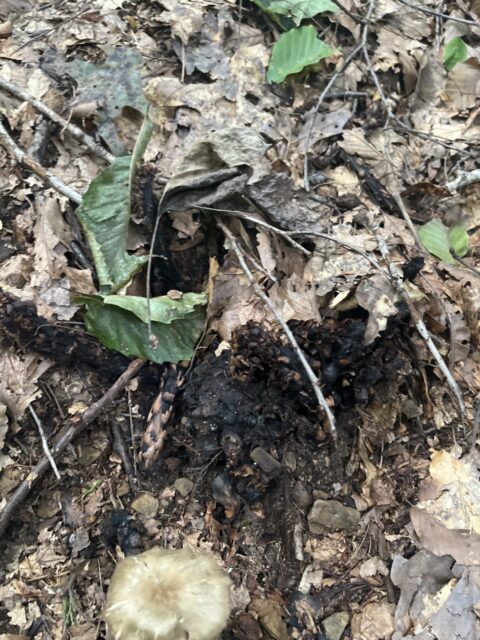
According to the book “Wildflowers of the Indiana Dunes National Park“There is some evidence of historical use of this plant by Native Americans as they used this plant for menopause. It has been used to tread hemorrhages and headaches as well as bleeding of the bowel and uterus.
Haircap moss (Polytrichum commune)
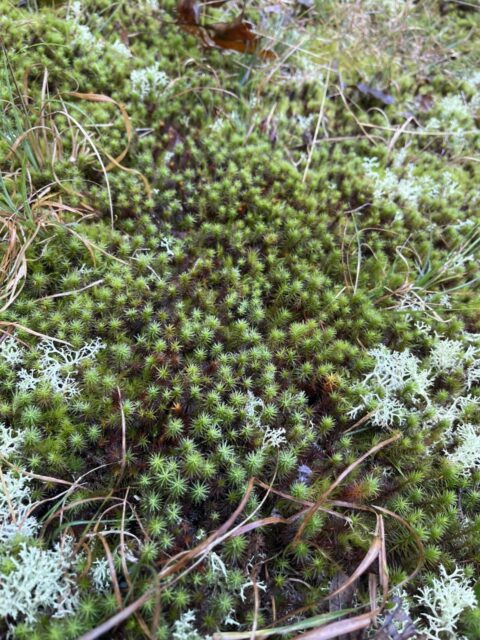
The Haircap moss grows in large patches and is distinguishable by its wiry spiked shoots which grow up to 40 cm long. This moss if mainly found in acidic habitats, and it is widespread o moist cliff faces, moist forests, and in sub alpine. The leaves typically 6-8 mm length, and its sheath is typically golden yellow. By using a microscope we could see the toothed leaves from the base of the blade up to the apex, these teeth being unicellular and embedded in the margin. Interestingly, the article “Bryophytes as Economic Plants” mentions that this plant was used by people in teas to relieve and dissolve gall bladder and kidney stones. Interesting, the consumption of this plant helps to dissolve gall bladder.
Japanese stilt grass (Microstegium vimineum)

The Japanese stilt grass resembles a small, delicate bamboo and has a sprawling habit. It grows up to 3.5 feet tall and it has leavesthat are 1-3 inch long. These leavesa re asymmetrical with an off-centered mid-rib, and are alternately arranged on the stalk. This plant is commonly found along roadways and ditches, and moist woodlands. This plant thrives in soils that are moist and acidic. This plant threatens wooded areas where tree canopies are defoliated over time due to infestations of gypsy moths or other destructive events. Especially in residential areas this plant can invade laws, landscape beds and vegetable gardens. Interestingly, grazers do not browse on this grass, research shows that native insects consume this plants. Animals like horses, goats avoid it because it has little to no value as food.
Pinesap (Monotropa hypopitys)

Pinesap is a plant with stems, leaves, and flowers that can be pale yellow, pale brown, or pale red. It is encountered almost everywhere in North America, it produces no chlorophyll and it is not depending on sun light. Furthermore, it can survive in shady areas. The flowers of this plant are about 1/2 inch long with 5 petals whihc are not fused. The leaves are non functional and have reduced down to frail lose scale like appendages. The entire plant is hairy. Interestingly, this plant receives its nutrients from underground networks of fungus which captures energy from nearby plants. According to the MDC portal this plant was historically used as an eye tonic, sedative, analgesic and general tonic. Consumption thus helped improving the eyesight of people.
